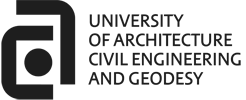Goals and objectives of the subject:
The goal of the subject is to develop in students a basic understanding and competence of finite element method. The course shows to the audience what is hidden into the “black box” of the FEM program. The learners should grasp the main idea and the logic of the development of the equations of the basic elements and global structure equations. The students should have an understanding of the basic components of a finite element model, such as elements of various types, degrees of freedom, loads, supports, material and geometrical properties.
Characteristics of the subject: This course teaches the fundamentals of the theory of the finite element method and finite element analysis of basic structures in civil engineering.
The lectures start with an introductory example of a bar extension problem with comparison of the results, obtained by an analytical and an approximate solution. The basic steps of the finite element development are outlined.
The theoretical part stars with the development of the equations and the stiffness matrix of the simplest element- a spring element. The assemblage of the global equations by the nodal equilibrium method and by the superposition method is explained on a simple spring structure. The example continuous by application of a homogeneous and non-homogeneous support conditions. The variational approach based on the minimum of the total potential energy functional is described as an alternative method for the derivation of the FE equations.
The development of bar equations is the next considered element. The general guidelines on a selection of the approximating function are briefly examined. The transformation of the displacement and force vectors and the stiffness matrix is developed to assembly the global equations of the entire truss structure. Another alternative approach is showed on bar element- the weighted residuals methods (collocation, sub-domain, least squares and Galerkin’s methods).
The beam and frame elements are developed in two versions: according to Euler-Bernoulli beam theory and according to Timoshenko beam theory. The beam element with a nodal hinge is developed by using of a condensed stiffness matrix. The loading on element is transferred as a nodal loading by a work-equivalence method.
The isoparametric formulation of the FE equations is showed on a simple bar element and later extended on a bilinear quad element in plane stress state. Numerical integration procedures are described for calculation of the components of the stiffness matrix and load vector. The Gauss quadrature method is applied on the stiffness matrix of a three-noded bar element. The restrictions for the location of the mid-node are considered.
A direct method for construction of shape functions of various plane element is considered. The basic idea of the “patch test” is described as a condition of the solution convergency. Different methods of a stress recovery are explained and compared on a bench-mark example.
The plate bending problem is presented by the development of a 12-degree-of-freedom plane element.
The course ends by a lecture on errors and pitfalls during the modelling process. Idealisation, mathematical errors, errors depend on the analysis type, discretization and numerical integration errors, round-off errors are described by series of examples. The problems with the mesh compatibility, concentrated force and re-entrant corner effects, offsets of the beam axis, rigid and elastic supports are considered as well. The lecture ends with the recommended basic steps during the planning of the FE analysis.
Acquired knowledge: Basic principles of current finite element modelling techniques, applied to trusses, 2D and 3D frames, shear walls, plates and shells. Discuss the limitations and application of current techniques and programs to solve complex engineering problems.
Acquired skills: Model an engineering structure without detailed instructions
Use FEA as a tool to solve a complex structural problem
Critically assess the results from FEA for correctness.
Preliminary requirements: Strength of materials
Finite Element Method
| Major | Structural Engineering - in English |
|---|---|
| Faculty | Faculty of Structural Engineering |
| Department | Structural Mechanics |
| Lead Lecturer | Assoc. Prof. Dr. Eng. Dobromir Dinev |
Year of education: III, Semester: 6, summer
Assessment: continuous assessment
Method of teaching: lectures and seminars
Total hours: 30 lectures and 30 seminars (Academic Hours)
ECTS credits 4
Books
Въведение в матричното смятане
Иван Марков
Иван Марков

